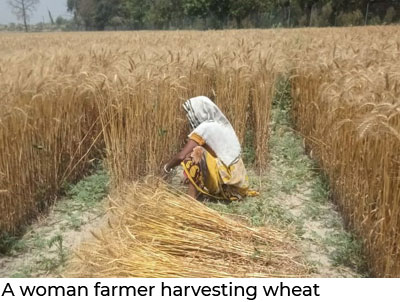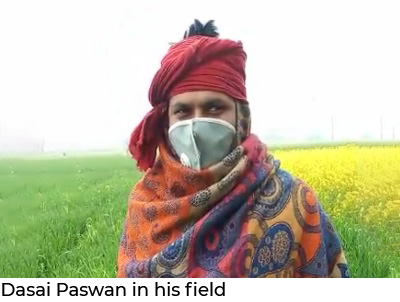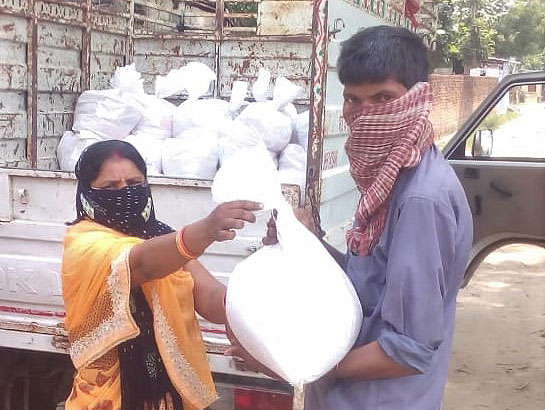When India announced a nationwide lockdown in March 2020 due to the COVID-19 pandemic, the country witnessed a mass exodus of migrant labor back to rural hometowns. The harvesting season, which generally starts around mid-April and is largely labor-dependent, was thrown into disarray, reducing yields across the country and disrupting food value chains. The resulting lower incomes for farming families and higher prices for some foods (due to supply squeezes) made it hard for them to afford sufficient food to eat.
Inaccessible markets, inadequate storage facilities, and radical changes in market demand led to a major dip in farmers’ incomes. Severe domestic and international travel restrictions during the lockdown added to their losses. Many farmers could not physically access markets or their fields because of these restrictions. A sharp decline in demand for perishable goods such as fruits, vegetables, and flowers forced many farmers to leave the produce to rot. Shipments of rice and perishables such as bananas, regular export items from India, have come to a standstill due to the worsening of the outbreak globally.
As of early 2021, lockdowns were no longer in place but farmers continued to face serious challenges. Many restrictions remain, such as bans on large gatherings and mandatory social distancing. Notably, the pandemic has forced the government to reduce its level of crop procurement, which has been a reliable source of income for many farmers. This means many farming families cannot afford to buy fruits, vegetables, and other nutritious foods for consumption. They also are unable to purchase wheat or paddy seeds to replace stored seeds they had to use during the lockdown period. As a result, the next harvest is likely to be significantly impacted.
The importance of agriculture
Agriculture, with its allied sectors, remains one of the largest sources of livelihoods in India. According to the census of 2011, 263 million people out of the total population of 1.2 billion were engaged in the agriculture sector. Almost 70 percent of India’s rural households depend on agriculture for their living; of these households, 82 percent are smallholders.
Smallholder farmers are critical to the food value chain in India and general economic growth. Large farms are mechanised whereas smallholders depend on manual labor, which provides employment to the general rural population; overall growth in smallholder agriculture can thus have a significant impact on rural well-being.
India’s smallholder farmers typically sell more than half of their harvest to earn necessary income, and they are extremely vulnerable to changes in market dynamics; farmers continue to face serious economic and nutritional challenges that arose due to COVID-19. The income farmers raise from produce sales is primarily used to pay off informal loans taken before the sowing season, and to pay for children’s education, healthcare, and other household expenses.
Even large landowners and farmers using machinery (combines) on their fields have suffered because of the pandemic. Combine harvesters need skilled drivers, many of whom hail from the Punjab and Haryana regions. These drivers were unable to travel because of the lockdown, hence it became difficult to use the combines to harvest their produce. The machines also break down quite often; the skilled drivers are trained to repair the combines.
“Non-availability of labor and agricultural machinery caused a delay in harvests. Limited availability of manpower led to a surge in labor costs. Unseasonal rains added to the challenges, and delays in harvests resulted in crop damage due to over-ripening,” observed Birendra Mendali, Project Manager, Bihar-Odisha project.
HarvestPlus has been working with its Indian partners to continue to reach and support smallholder farmers whose livelihoods have been affected by the pandemic. One partner is Sustainable Human Development Association (SHDA), a well-established non-profit organization based in Gorakhpur district, which is in the eastern part of Uttar Pradesh (UP) State. In partnership with HarvestPlus, SHDA has been working on scaling up the production of zinc-biofortified wheat in 12 districts of UP and six in Bihar since 2013. SHDA also implements several livelihood programs with support from both public and private organizations, for smallholder farming households in the surrounding areas.
In April 2020, when the pandemic had begun to affect countries worldwide and was gaining ground in India, SHDA reached out to 998 vulnerable families—including people with disabilities, smallholders, and migrant laborers—to distribute 28 tons of biofortified zinc wheat for consumption, which had earlier been stored as seed for the next season. Each household received 7 kilograms of zinc wheat every month for four months. All distributions were made according to the safety guidelines issued by the Government of India, with social distancing practices in place.
This measure by SHDA is an effort to reach out to the community with food that adds the nutritional benefits of biofortified crops. The distribution of locally-grown biofortified zinc wheat offers these farmers the advantage of consuming localized nutritious food that is less prone to transportation and supply disruptions.
 In Bihar, India’s third most populous state which has the country’s lowest level of per-capita GDP, there has been a large-scale reverse migration trend after millions of migrant workers returned home and were hesitant to return to work for the fear of getting infected with the Coronavirus. Farmers faced many challenges to save their winter (rabi) crop after the alarming labor crisis. Also, due to disturbances in processing and supply of seeds coupled with travel restrictions, many farmers in Bihar have mostly relied on the seeds they have saved from the previous season. Trade restrictions forced the smallholder farmers to sell their produce to local traders at lower prices, resulting in meagre returns. In the case of zinc wheat and perishable organic produce, which require special storage facilities and supply chain operations, these harvests had to be sold to local traders. Farmers suffered low returns and big buyers couldn’t aggregate the quantities they desired.
In Bihar, India’s third most populous state which has the country’s lowest level of per-capita GDP, there has been a large-scale reverse migration trend after millions of migrant workers returned home and were hesitant to return to work for the fear of getting infected with the Coronavirus. Farmers faced many challenges to save their winter (rabi) crop after the alarming labor crisis. Also, due to disturbances in processing and supply of seeds coupled with travel restrictions, many farmers in Bihar have mostly relied on the seeds they have saved from the previous season. Trade restrictions forced the smallholder farmers to sell their produce to local traders at lower prices, resulting in meagre returns. In the case of zinc wheat and perishable organic produce, which require special storage facilities and supply chain operations, these harvests had to be sold to local traders. Farmers suffered low returns and big buyers couldn’t aggregate the quantities they desired.
“We spent a lot on hiring agricultural labor for harvesting our crops and had to sell our produce at much lower rates. Wheat was sold at a loss of 30 percent, maize at 50 percent, vegetables at 75 percent and milk at 25 percent less than the regular prices. Many of us ended up taking loans from informal sources at very high interest rates. Not having enough to eat was what we were worried about the most, despite growing our own food. Survival came first, thinking of adequate nutrition was far from our minds,” said Muhammad Rizwan Ansari, from village Semra in Bihar.
A strong immune system is the first line of defence against infections like COVID-19. Biofortified crops offer essential micronutrients that strengthen the immune system. Currently, there is an opportunity to push strategies that can increase the reach of biofortified crops in a sustainable manner. It is vital to develop more formal and cooperative- based value chains and farmer-producer organizations (FPOs) which can provide smallholder farmers with training and information on the benefits of growing biofortified food and the use of digital platforms, in order to realise better return on their farm investments.
“I had moved outside Bihar to make a living. I returned as the lockdown was announced. I wanted to farm but I had no money to buy seed. The seed that I saved from last year decayed. I received biofortified zinc wheat seed from HarvestPlus and today my field looks green and prosperous. I am happy I can provide nutritious food for my family. I will continue to farm in my village now,” said Dasai Paswan, from Champaran, Bihar.
 HarvestPlus has operated in India for nearly nine years, in close collaboration with partners in the public and private sector to improve nutrition and public health by developing and promoting biofortified crops and building out biofortified seed and crop value chains. These biofortified crops—iron pearl millet, iron lentil and zinc wheat— boost the levels of much needed iron and zinc available in the diet, helping to alleviate micronutrient deficiencies.
HarvestPlus has operated in India for nearly nine years, in close collaboration with partners in the public and private sector to improve nutrition and public health by developing and promoting biofortified crops and building out biofortified seed and crop value chains. These biofortified crops—iron pearl millet, iron lentil and zinc wheat— boost the levels of much needed iron and zinc available in the diet, helping to alleviate micronutrient deficiencies.
Zinc wheat is currently grown by about 442,000 farming households in India, with an estimated 2.1 million household members benefiting. Thanks to partnerships in both the public and private sectors, and a generous investment by the Bill & Melinda Gates Foundation, improved varieties of zinc wheat are being made available to farming communities where they are most needed. Indian Prime Minister Narendra Modi has given a strong endorsement to staple crop biofortification as a sustainable and cost-effective solution to alleviate malnutrition.
As we continue to deal with the COVID-19 crisis in 2021, it has magnified the vulnerabilities already present in the food system in India such as poor infrastructure, lack of institutional support, bottlenecks in agricultural supply chain, access to nutritious foods, and market risks.
It is critical to take stock of the issues and help businesses create more resilient food supply chains and measures to support our smallholder farmers who play a crucial role in keeping our food supply chains afloat.
